Renewable energy is becoming more popular for countries to embrace and to include in the national power grid. It is also increasingly a choice for small communities and for individuals. The ability to generate your own power and to live without dependence on the public power grid is a viable choice for many.
Hybrid power systems can integrate and capture various forms of natural energy, including solar, wind and water, as well as connect to standalone generators and the public power grid. This article explains how these systems work and what choices are available.
Table of Contents
The market growth of hybrid power systems
An introduction to hybrid power systems
Components of a hybrid power system
How to select the right size of hybrid power system
Final thoughts
The market growth of hybrid power systems
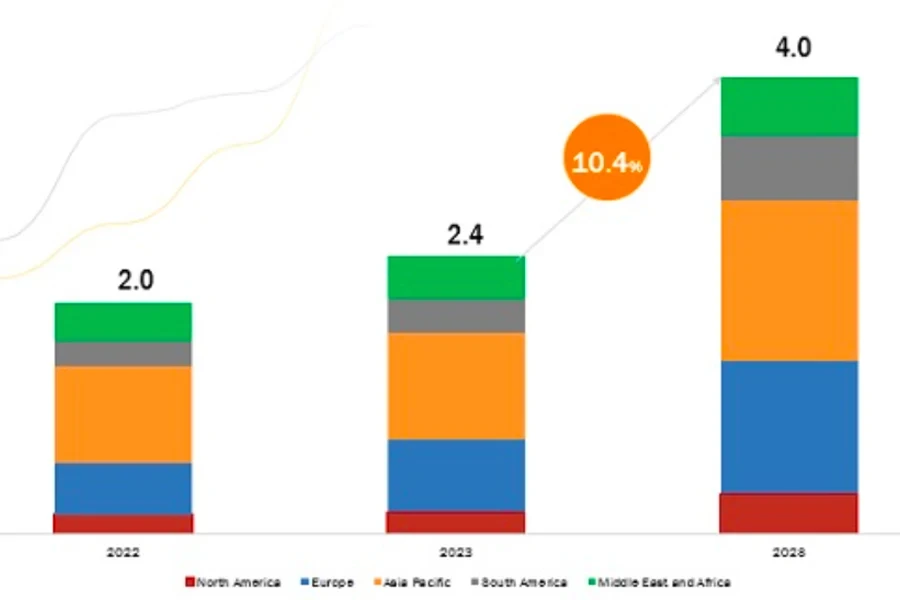
Hybrid power systems are becoming increasingly popular across the world, for homes that see flexibility and cost savings in making use of renewable energy to minimize reliance on an increasingly expensive public grid.
In many countries, there is government support and tax benefits for homes that make use of renewable energy systems, and some countries will buy back surplus power from users where available.
The global market for hybrid power systems was US$ 2 billion in 2022, and is projected to grow at a very positive 10.4% compound annual growth rate (CAGR), from US$ 2.4 billion in 2023 to around US$ 4 billion by 2028. The European and Asia Pacific regions are showing the highest growth as shown in the above chart.
An introduction to hybrid power systems

Power can be generated from many natural sources and the technology exists to capture and integrate that power at the national level. However, all of these technologies are now available at a small scale that can be used for farms, small communities, and even for individual homes.
Most people are familiar with solar panels on homes to help generate power for the home. Those who live on farms may also be familiar with using wind turbines for power. And some may use nearby flowing water sources to generate power. All of these are very well established means of using natural energy sources to supplement or to provide complete electrical power needs for the home.
Homes that only use power from the public utility grid are referred to as ‘grid-tied’, or ‘on-grid’, whereas homes that generate their entire power needs themselves and do not use the public grid are called ‘off-grid’. People that live in isolated areas are often entirely living off-grid, whether out of necessity or by choice.
Hybrid power systems, such as the 5-10 Kw system shown above, can integrate the electricity generated from multiple natural sources. If necessary they can combine with other power sources such as the public grid and stand-alone fuel generators. The systems can switch between different grid modes depending on the power sources available.
Hybrid power systems can use one or more means to capture energy, with options usually being solar photovoltaic (PV) panels and small scale wind turbines, but may also include mini hydro turbines.
For each source, the energy is captured, either as direct current (DC) or as alternating current (AC). It is regulated and stored as DC in a bank, or array, of batteries. This DC current is then made available to the home as DC current, or by converting to AC using an inverter, from which it can then be used by home appliances as needed.
Components of a hybrid power system
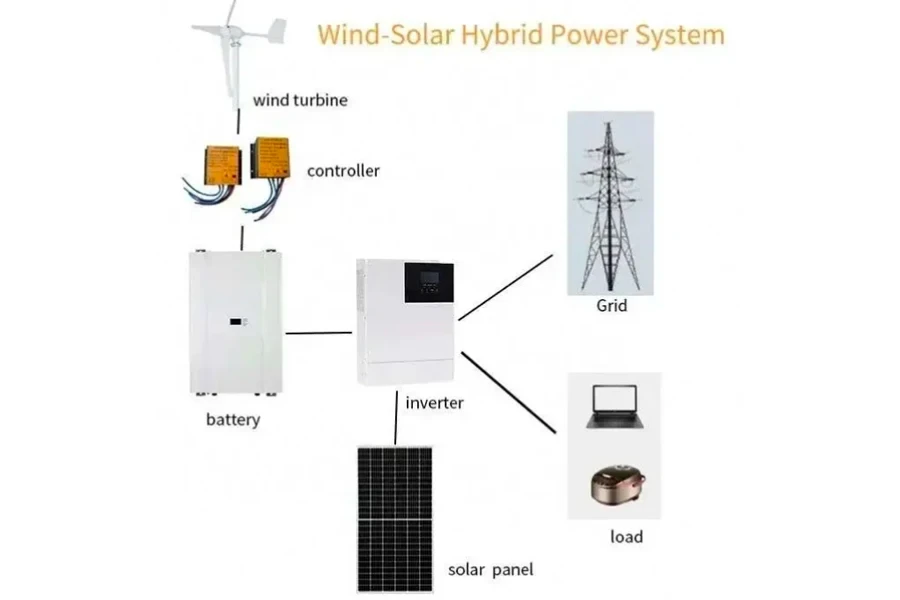
Most commercially available hybrid power systems come inclusive of solar and wind solutions. They do not typically include any other solutions such as generators, hydro solutions, or other forms of energy provision such as biomass. Systems that only include solar PV panels, and no wind turbine options, are usually advertised as hybrid ‘solar’ systems.
Solar panels come in a range of different sizes and powers, from around 100 watts to upwards of 700 watts per panel. It is usual to build an array of panels across a roof, across a flat space, or at an angle facing towards the sun.
Wind turbines come in two main versions, horizontal (propeller) type, and vertical (egg-beater) type. There are hybrid power system packages available with both types of turbine.
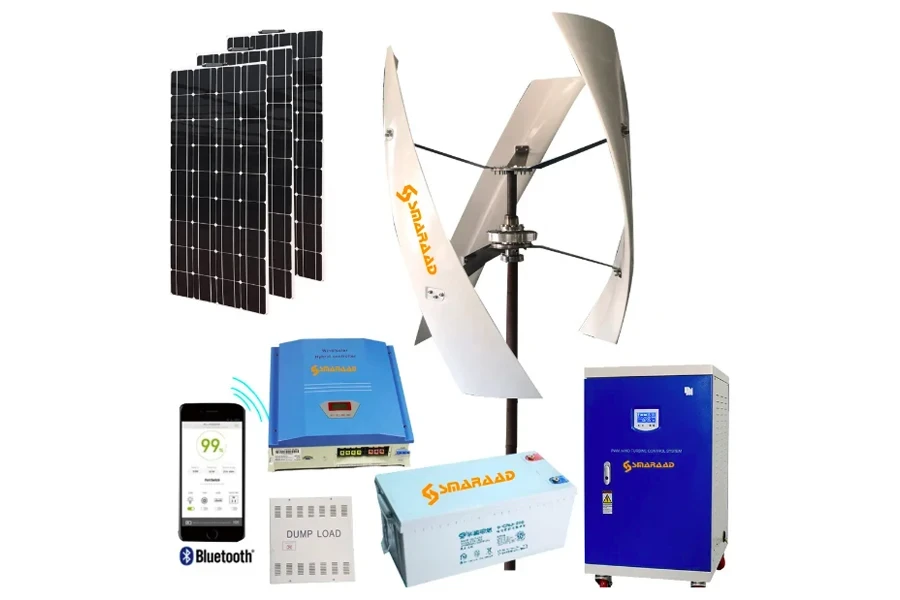
Some providers price their packages from a starting price, and a final price depending on the number of solar panels, wind turbines and power of the controller and inverter.
The power controller and inverter
At the ‘heart’ of the hybrid power system are the controller and the inverter.
The main role of the hybrid power inverter is to convert direct current (DC) into alternating current (AC). The public power grid uses AC as this is the most efficient current for transmission over distance. Domestic home electrical supply is also AC, as are most home appliances.
However, solar PV panels generate unstable DC, whereas wind and water turbines generate unstable AC power. Storage batteries use DC as the most efficient way to hold the current. Therefore the system must be able to stabilize any power that is received, and convert it to DC current for storage. That is the job of the hybrid power controller.

Stabilizing and converting power can be managed with a separate controller, such as in the above supplier off-grid diagram of a hybrid wind and solar power system, showing a wind/solar hybrid controller feeding into the battery. The stored battery power is then converted to AC by the inverter that feeds the home appliances.
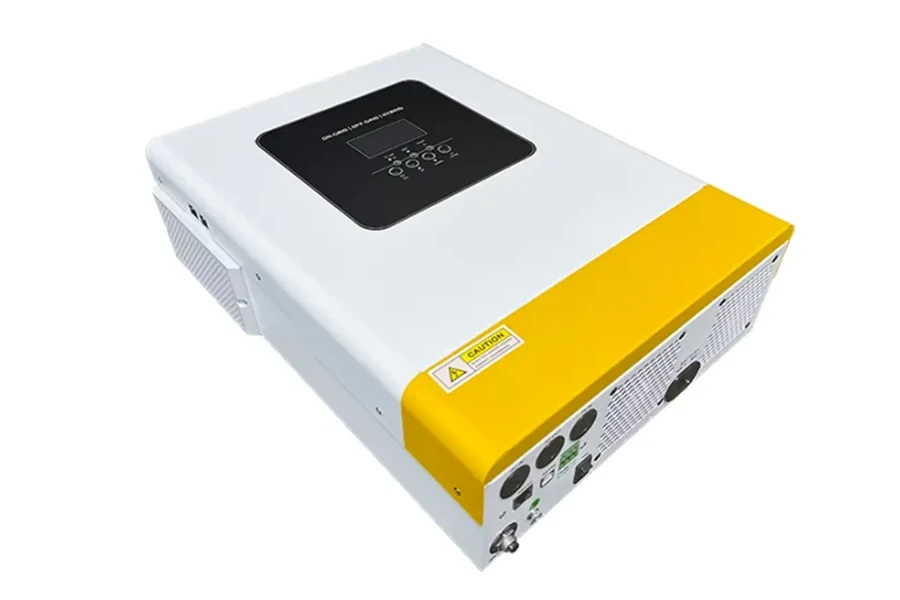
However, some modern inverters function both as a controller as well as an inverter, and also can provide advanced management functionality, such as cloud and computer data reporting.
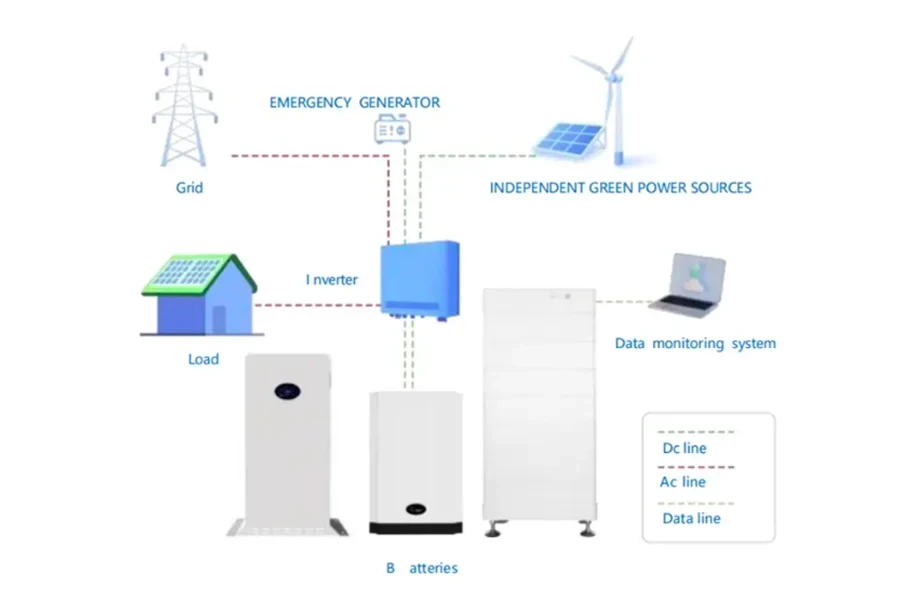
In the above diagram of a hybrid power system, all supply connects directly to the inverter, including from renewable (green power) sources, public grid and home generator. The hybrid power inverter regulates current from all the different sources, stores it, and accesses it when required for home supply.
Modern intelligent inverters provide flexible power management to:
- control the renewable energy charge,
- store the energy in a battery array,
- monitor and report on battery charge levels,
- switch usage between public utility grid and batteries,
- convert stored DC current to AC current,
- supply electricity to home applications,
- supply any surplus power back to the public utility grid
- provide real time data to the cloud and to local computers.
Pure sine wave inverters produce a highly stabilized AC current that matches the current of the public utility grid. This is necessary to provide a high quality clean and reliable power to home appliances, many of which contain sensitive electronics.
Lithium ion battery arrays
Whatever energy is captured, it must be stored for use when required. This is done with an array, or bank, of lithium ion batteries. Battery storage comes in many forms, from very basic batteries ‘tied together’ with cable, to modern clean cabinets that do not look out of place in the home and also allow remote monitoring.
The amount of battery storage required will depend on the user’s domestic power consumption requirements, and to what extent the user wants to remain independent of the local grid. The more power that is stored, the more electricity available for off-grid usage.
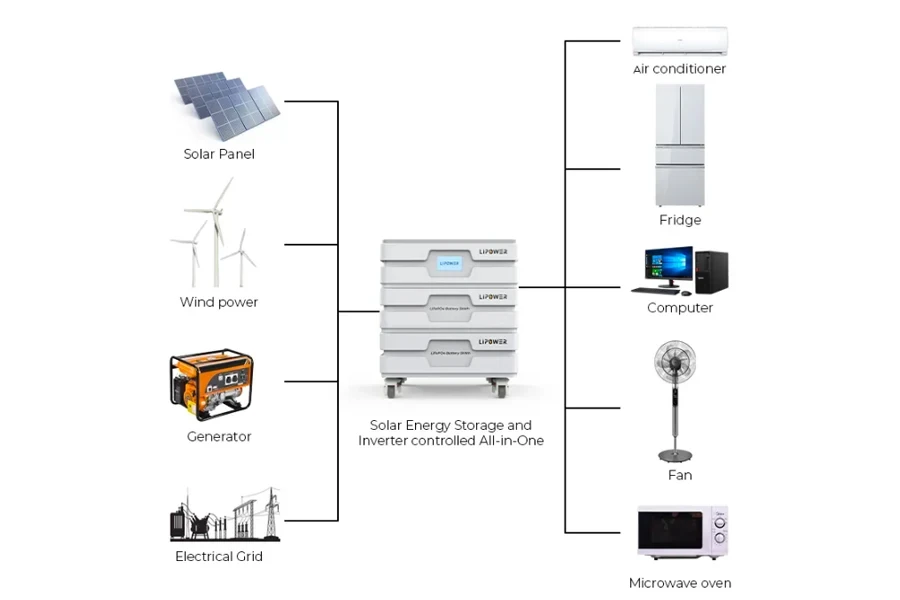
This stacked battery and inverter array has a clean cabinet look that makes it suitable for inside the home. It is stackable and configurable in multiples of 5 Kw battery layers, and comes as an all-in-one system together with an inverter and a controller layer. With four battery layers, it can deliver 20 Kilowatts of power per hour to the home. Performance and battery levels can be monitored through the LED displays as well as online through cloud and computer. Pricing starts at around US$749 and will depend on the number of battery layers ordered.
How to select the right hybrid power system
Renewable energy capture choices
When selecting a hybrid power system, the first decision should be which types of renewable energy are intended to be installed, with most complete systems including wind and solar, and whether the system is to be off-grid or hybrid.
There are many systems available that offer choices of wind turbine and solar panels. Check the power rating (in Kilowatts) that the system is specified to produce, for both the wind components and the solar panels.
If hydro power or a local generator are also required, then the buyer should check for any issues with connectivity with the supplier. If the system is to connect to the public utility grid, the buyer should be clear on whether power is to come mainly from renewable energy, or mainly from the public grid, and how the system will switch between the two.
Inverter capacity
The decision on an inverter is determined by the amount of power that is to be used by the home at any one time.
The buyer should calculate the expected maximum concurrent energy demand, and how much power is likely to be needed on an hourly basis. For example, how many different appliances will be run at the same time, and which appliances would they be?
Cooking is an example of high demand as most kitchen appliances are used at the same time and can all draw down upwards of 3 Kw individually. The inverter must have sufficient Kw per hour (Kwh) capacity to meet the most extreme needs, or the inverter can be overloaded.
Controller, energy storage and battery arrays
The decision on controller and battery capacity is determined by the amount of power that is to be collected and stored. The buyer should calculate how much battery storage will be needed on a daily basis and estimate where (and when) that power will be generated.
For example, if wind turbines are used, what is the likely amount of power generated through the day on an average windy day? What amount of sunlight will the solar PV panels be able to capture and during what daylight hours? If the public utility grid is to be used, will it be at specific hours, such as off-peak?
The choice of controller must be adequate for the different energy sources, and the battery capacity should be adequate for all of the likely needs during the day, factoring in when battery charge is likely to happen.
Supplier assistance
Your supplier should be able to help with calculations, and may offer a spreadsheet to help you estimate daily needs, including peaks for energy capture as well as peaks for energy usage.
It is usual to plan usage in Kilowatts, based on the calculated daily and concurrent use. Your monthly utility bills, divided down to a daily amount, can give the overall average usage, and therefore overall storage required.
However, you should also look for the peaks of use. Mealtimes are a common peak, and several commonly used appliances have a high power demand. Ovens, microwaves, electric kettles, air fryers and toasters are all examples that can use between 1-4Kw, so when all added together give the likely concurrent power draw down. Also remember that other appliances may be used at the same time. Home heating, water heating, power amplifiers, tv and home WiFi, and electric car charging. All of these are using power too.
Surplus power and grid feedback
If the cost model is to generate surplus supply that can be fed back to the public utility grid, then the estimate must include that surplus, as that may require additional wind turbines or solar panels.
When installing a hybrid power system, it is important to bear in mind that there is a large upfront cost before cost savings can be achieved. The turbines and PV panels, controller and inverter, and the battery array can be expensive, plus installation costs and an additional amount for periodic maintenance.
Return on investment may take years, rather than months, so the intended system must not only fit within budget, but also consider ongoing costs.
Final thoughts
The availability of small scale hybrid power systems allow the residential market to make best use of different renewable energy sources, combined with the public utility grid. Typical systems come with either vertical or horizontal wind turbines that are suitable for home use. These systems are also packaged with solar PV panels that can be conveniently sited on the roof.
There is a wide choice of hybrid power systems available, which include the main components of hybrid power controllers, inverters, storage battery arrays, and smart monitoring software. The buyer will need to be clear on power needs, how much is needed to be generated and how much is needed to be used by the home at any one time.
Hybrid power systems require an upfront investment in the equipment and installation, and the buyer should be aware that ROI is likely to be spread over a long period. The supplier should be able to assist with calculations to determine the right size of system, and a range of choices can be found at the online showroom at Chovm.com.

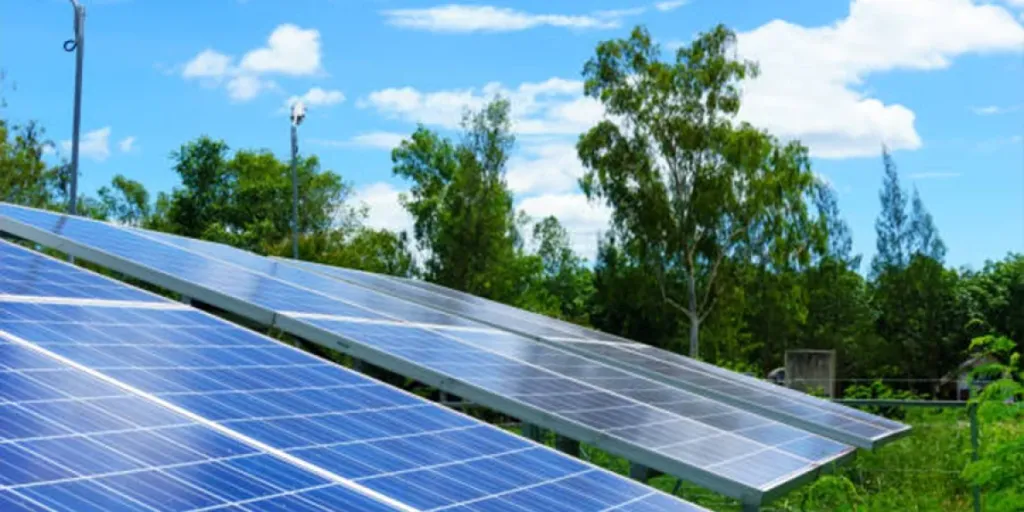
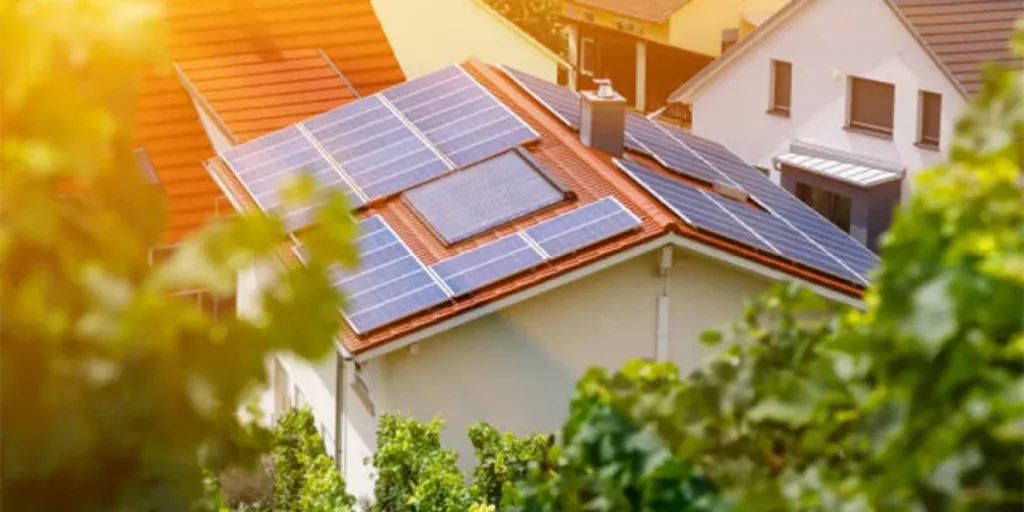


 বাংলা
বাংলা Nederlands
Nederlands English
English Français
Français Deutsch
Deutsch हिन्दी
हिन्दी Bahasa Indonesia
Bahasa Indonesia Italiano
Italiano 日本語
日本語 한국어
한국어 Bahasa Melayu
Bahasa Melayu മലയാളം
മലയാളം پښتو
پښتو فارسی
فارسی Polski
Polski Português
Português Русский
Русский Español
Español Kiswahili
Kiswahili ไทย
ไทย Türkçe
Türkçe اردو
اردو Tiếng Việt
Tiếng Việt isiXhosa
isiXhosa Zulu
Zulu